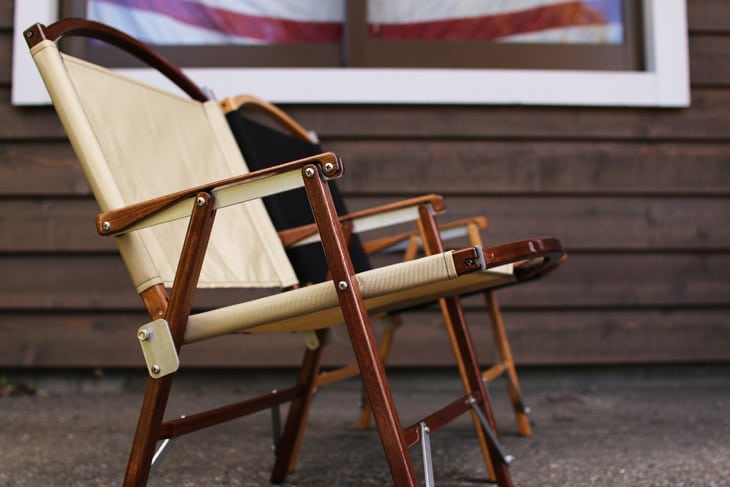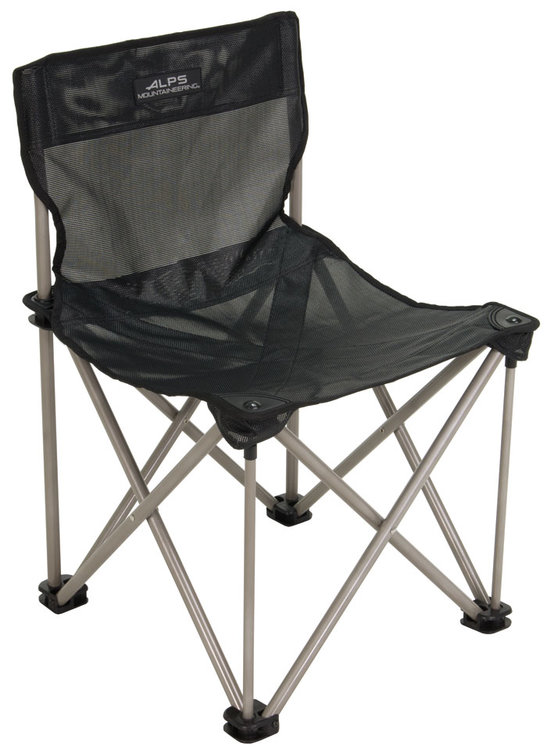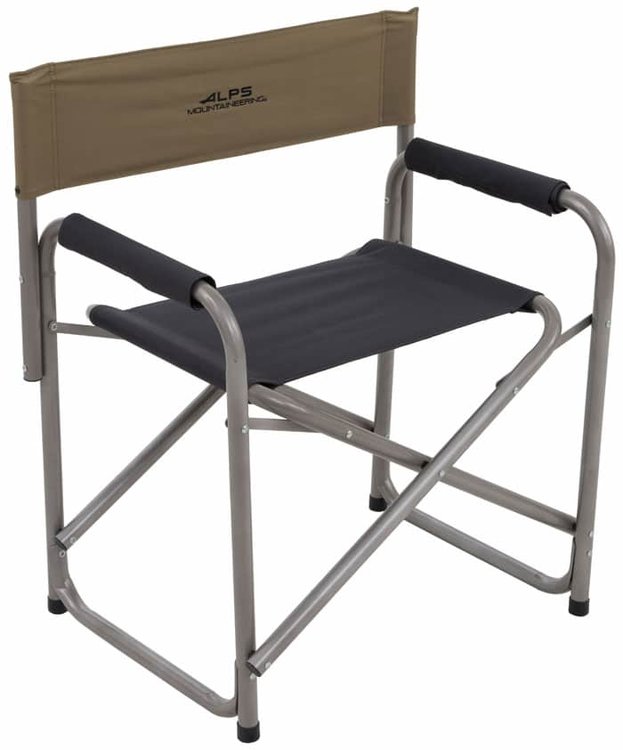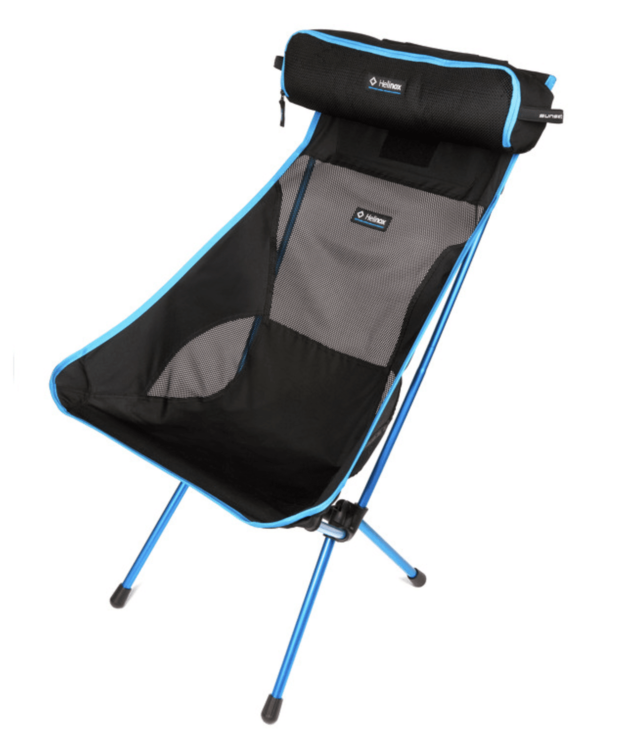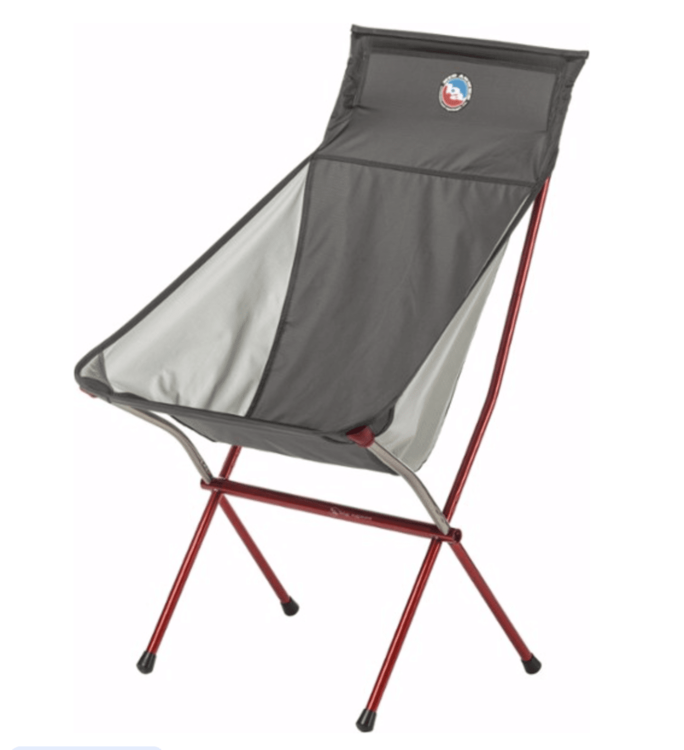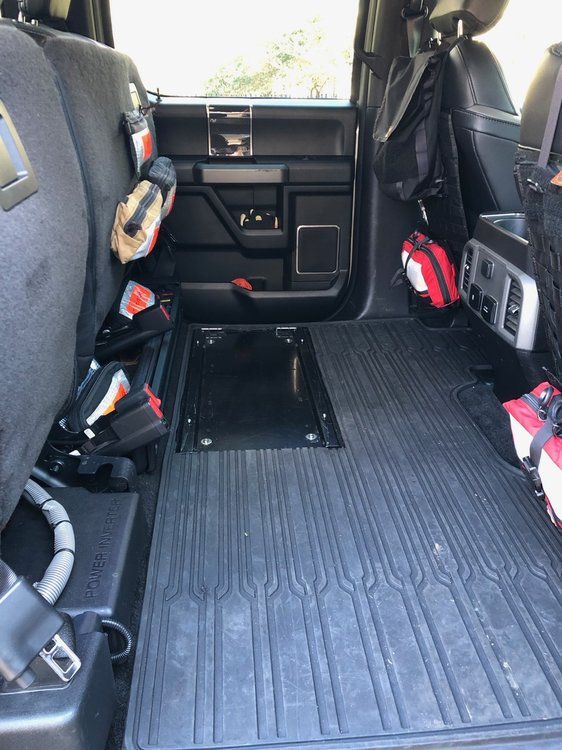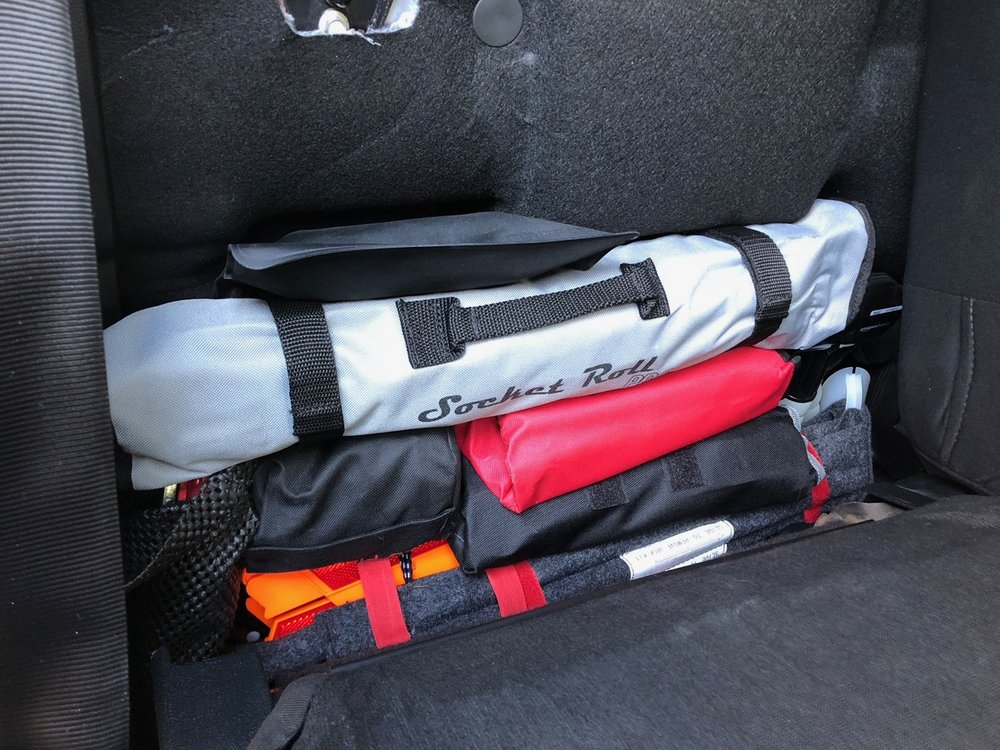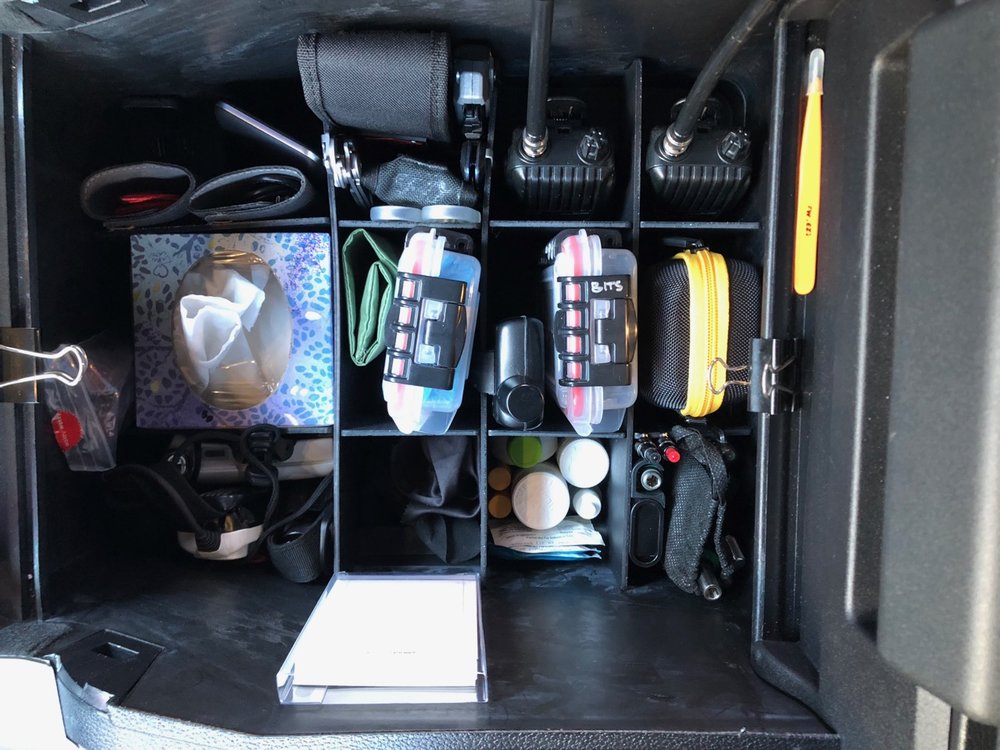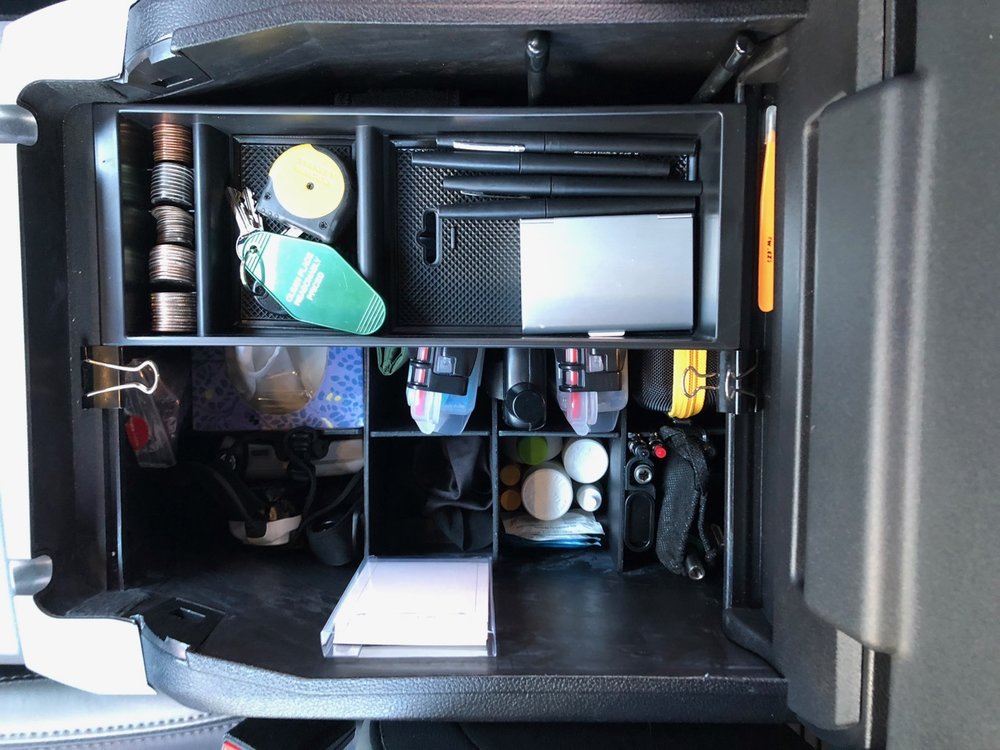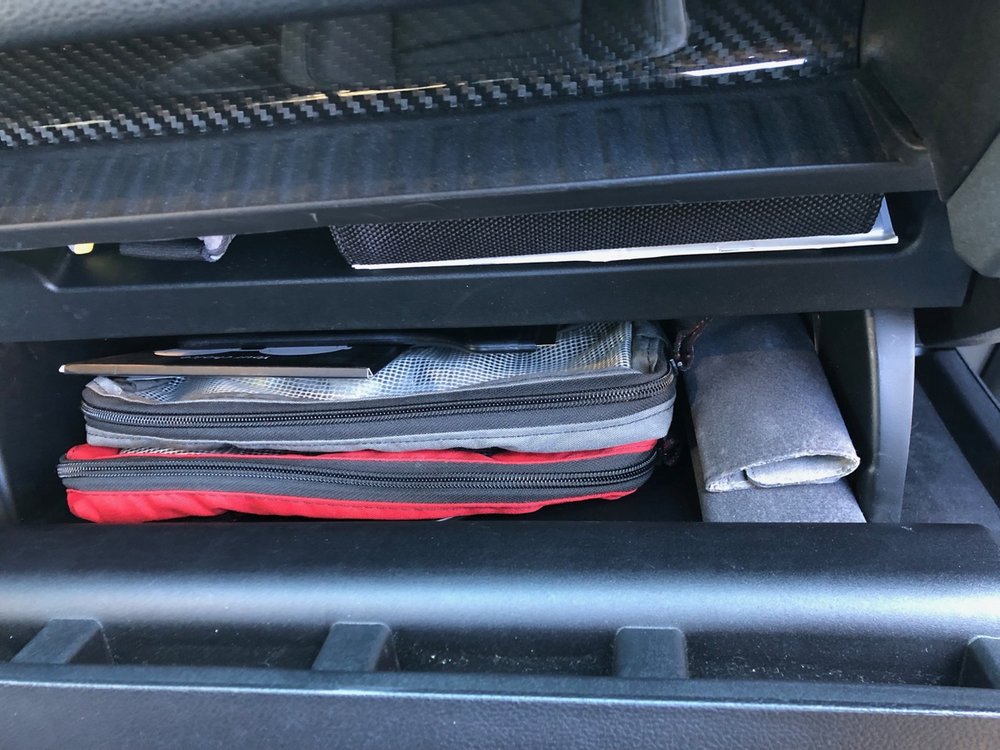-
Posts
3,835 -
Joined
-
Last visited
-
Days Won
212
Everything posted by Overland
-
Tom is correct. Both require an adapter, so the real question is whether you want to spend $100 more just to use (and carry) a different adapter. I also think someone posted about a problem bonding the ground and neutral on the companion model.
-
I just read a reviewvertisement of the Stargaze Recliner from Nemo. Looks like a neat idea, and well executed. It's another expensive one though.
-
I've also always thought that these Kermit chairs are pretty neat. They seem to pack up well, and are beautiful to look at. But $$$ and I'd probably get tired of the assembly time. Gorgeous, though -
-
Timely question, since I'm trying to convince my wife now that we need to rethink our chair game. At the moment, we have three sets of chairs that we've collected over time. The first, which we got years ago, is the armless scissors style or quad chair like this one from Alps Mountaineering: Ours are from LL Bean, I think, from back in the early 90's. They've held up well and gotten a lot of use, but they're heavy and only good for lounging around; i.e., you wouldn't want to try to eat at a table with them. They have a relatively low seat height and you slouch back in them when you sit. They'd probably be difficult to get out of for someone who's elderly. They pack up into a tube shaped bag, and in that respect are fairly easy to pack. We don't really use them anymore. In our later car camping days, we wanted something that wasn't so loungy, and so we got these directors chairs: I like these a lot. They're super sturdy with a normal seat height and straight back that makes them great for use with a table. They're also heavy, and don't pack compactly at all. They're also steel, and water will get into the tubes - so if you leave them out in the rain, you'll get rusty water dripping out the legs. When we got our Ollie, we figured we'd have enough space to upgrade to some zero gravity chairs: These are sort of in between as far as seat height and position. They're probably too clumsy and heavy to use well with a table, but they make fantastic loungers and are stiff enough that an elderly person can probably get in and out of them without difficulty. They're great for soaking up the sun or stargazing. They're also steel tube. Also heavy - and not compact in the least. My wife loves the Zero-G chairs, and so do I; but I don't like at all how clumsy and difficult to pack they are. The directors chairs are a bit more packable, but we've found that we don't eat outside a lot with the Ollie (at least not at a table), so they don't really make a lot of sense to take anymore. At the moment, I'm into making everything more compact, lighter and efficient, so in my mind, the Zero-G chairs have got to go, but I've yet to convince my wife. What I'd like to switch to are Helinox Chairs, which are super light and super compact. And they're also pretty sturdy, despite their appearance. They're a little on the loungy side, but their Sunset and XL models have a normal seat height and I think that in a pinch, they'd work fine with a table. To me, their high backed Sunset chair would be a good compromise between our Zero-G's and Director chairs. I just need to convince my wife. They're not cheap, either. In the same vein, Big Agnes has just released their own line of camp chairs, which have a somewhat different design but are just as light and compact (and just as expensive): I'd like to see one in person though before spending that much money on one. In truth, I'd be fine with a good sized rock, but man are those hard to pack.
-

Bike rack owners: need tray location from bumper, in inches
Overland replied to John E Davies's topic in Ollie Modifications
I don't have any plastic spacers on mine. Perhaps that was a later addition. I don't think that the fender washers they use are oversized, but they're only used on the top against the receiver tubes. On the bottom, they're standard washers. They may be lock washers. The frame is also heavily reinforced there with a C channel that transfers the compression forces to the flanges, or tube walls. The receiver tubes and diamond plate do the same for the top. Sure a compression tube would make it stronger, but for any reasonable load I see zero issues with Oliver's design. I suspect that Oliver changed the design because a) its impossible to keep the two receiver tubes aligned well enough to make sliding the platform rack on and off easy - especially since the tubes are set on diamond plate so they tend to move and twist when tightened; and b) they didn't want to be in the bike rack business and the new design allows owners to buy whatever rack they want without bothering the production floor with special requests. -
It's the Lansa handle, in I think the largest size. VHB Tape
- 47 replies
-
- 1
-

-
- counter
- counter extension
-
(and 2 more)
Tagged with:
-

Bike rack owners: need tray location from bumper, in inches
Overland replied to John E Davies's topic in Ollie Modifications
If you're putting enough torque on those bolts to bend the frame, then I'm going to say that you're putting too much torque on those bolts. And likewise, if what you're carrying requires that much torque, then you're carrying too much weight back there. Having said that, going in through the side would be much more likely to bend the frame, due to its geometry. And you're also stressing both the bolts and frame in shear. So top to bottom is definitely the better design. I'd think that Oliver's "platform" frame is made of light enough material that it would crumple before damaging the frame. -
Maybe some felt pads on the angle would keep it from scuffing up either the top or inside of the drawer.
-
That’s a great idea, Bill. I’ve been looking for a good solution for that drawer.
-
Conquerors are heavy duty, but personally I don’t think they’d work well for travel in the US. Too much to set up every day, too much canvas for use in a wet climate, and like you mentioned, no indoor kitchen or shower for cold nights and mornings. I had a chance to buy a used one from someone who actually lived near us, but I declined after watching their setup video - lots of insert tab A into slot B sort of stuff. I think in daily use it would be too much of a pain to set up the entire kit. And with all that canvas, I couldn’t help but think we’d be buying a big box of mildew. I think they’re probably great for warm and dry climates like South Africa.
-
I use Backblaze for remote backup of my server and they issue regular reports on failure rates for the various brands of the over 100,000 hard drives used in their servers. I’ve switched to SSD now but prior to that, these reports were a great resource when it came to choosing a drive. The only HDs I’ve ever had fail were OEM. Hard Drive Stats 2018 Kudos to Backblaze for being so open about their operations. I have zero complaints about their software or service. Anyone looking for a remote backup solution would be wise to check them out.
-
You might take a look at Black Series campers. They've been in Australia for a while, and they just started up a factory in SoCal. I toured some of them earlier this year and they seem well made.
-
I was thinking of doing a separate topic about spares and stuff. But I carry much of what you do. One thing I haven't done yet (but need to), is to repack my wheel bearings. I suspect after tackling that the first time, I'll add one or two more tools to the kit specifically for that task (maybe a hammer and larger screwdriver to knock out the inner bearing).
- 18 replies
-
Thanks, I’m curious how you use those vice grips since I’ve never owned a pair like that - you're talking about the larger C-clamp style ones, right? One thing I forgot is that I also keep a set of drill bits along with a chuck that fits my impact driver. They’re in a bag that’s stuffed in the seat back pocket on the drivers side. I'll edit my post to include them.
- 18 replies
-

Has anyone used Separret Villa 9215 Composting Toilet?
Overland replied to PeteRissler's topic in Ollie Boondocking
Well, I think the answer to that question is that big fan. If I were considering this for my house, with the vent 15'-20' in the air, I think I'd put this high on the list. But on a trailer, I suspect that the exhaust is just too close to the ground. I could be wrong though - it would be interesting to hear from someone who's put it in an RV or trailer. -

Who hates those @#$&*! chip sealed highways?
Overland replied to John E Davies's topic in Towing an Oliver
It seems to be more prevalent where you live. At least I haven't run into it much in the southeast or southwest, but have come across two or three roads being chip sealed in the northwest. -

Has anyone used Separret Villa 9215 Composting Toilet?
Overland replied to PeteRissler's topic in Ollie Boondocking
Interesting. I haven't heard of that unit, but I can see a few advantages over the Nature's Head. It looks like it's heavily dependent on ventilation, though, and a 3" vent pipe might be difficult to get to the roof and cap. I don't think you'd want to vent it out the side due to odor, and in fact you might get a wife or two from a top mounted vent as well. It certainly looks nicer than the Nature's Head, and also looks like you can go longer before emptying. -
Storage I'm not a fan at all of tool boxes for inside the vehicle. They're noisy, bulky, and your tools get scuffed up. If you're keeping your tools in the back of the truck and don't care if they get banged around, then go for it. I have mixed feelings about tool rolls. On the one hand, they're the classic way of storing tools for travel, they're relatively compact, they keep your tools protected and quiet, and they keep everything organized and easy to find. But while great in theory, I've had a hard time finding tool rolls that work well in practice. Too few pockets, too many pockets, the pockets are too narrow to fit your tools, or too wide and your tools fall out, or they're too short for that one wrench that you then can't find a place for, etc. I have found that they're great if they're tailored for a specific tool kit, like the Tekton Wrench Sets above, and I do like the Socket Roll that I mentioned earlier. I do use this tool roll for my wrenches and this one for my misc. stuff. In both those cases, I bought the rolls so I'm determined to use them; but honestly, I'd rather use bags. But those leather rolls do smell great. What I really like are tool bags. Specifically, I like having my tools divided into a number of small tool bags that I can grab individually rather than pull out a big, heavy bag with all my tools in it. I've had good luck with these bags from Blue Ridge Overland. They're a little pricey, but they're good quality; and most importantly, they just seem to be the right size and proportion. The vinyl front doesn't really let you see anything inside, like they claim, but what it does do is provide a nice surface for some bright orange gorilla tape, which can be marked with a fat sharpie and is perfect for labeling the bags. I've found that these bags stuff well wherever I want them, and they're flexible enough to wrap around the tools to keep them quiet and protected. I absolutely hate rattles in cars, and these bags keep me happy. I also like these waterproof DAKA bags from Magpul. They're more expensive than the Blue Ridge bags, but they're definitely tougher. Plus they have a nice grippy surface, so I can see them being a good choice if you have to get out in the rain. I've tried cheaper bags from Home Depot and places, but those always end up being a difficult size to fit things in, or they tear up and so I seem to keep buying the ones from Blue Ridge. This larger size version fits my impact wrench, work light, charger, and spare batteries perfectly. As for how much space in the truck all of this takes up, well, judge for yourself: About half of the tools go into the storage tray under the rear seat. The ones velcroed to the seat bottom hold tape, zip ties, electrical repair stuff, etc. (The red bags on the back seat are first aid kits, which get stuffed into backpacks when we travel, and the larger black bag is for trash.) The remaining tools go behind the smaller, fold down seat back: The center console is packed, but is organized well enough that it stays that way: And even the glove box stays clean - the grey bag holds the key to my wheel locks and a few other things that the dealer might need to get to, and the red one holds a couple EpiPens and some other first aid things. Then some USB cables, window scraper, owners manual, and a pair of gloves: So there you go - a (hopefully) complete tool kit that takes up next to nothing inside the truck.
- 18 replies
-
- 6
-

-

-
Misc. Stuff Since I'm carrying my impact driver, I thought a small work light that uses the same batteries would be useful to have. I keep one small tool roll with some brushes, picks and other do-dads that might come in handy. Most of these you could pick up at Harbor Freight since they don't need to be the highest quality: Craftsman Pick Set - just a small, cheap set that I had in the house. Any similar set would do. Craftsman Retaining Ring Pliers - these are cheaply made, but also very compact GearWrench Inspection Mirror GearWrench Telescoping Magnet - for retrieving all those bits Wire Brushes In the center console of the truck, I have one of these dividers (they make them for all makes and models), which allows me to carry these tools in addition to the normal center console stuff: Fluke 107 Multimeter - I think this is the smallest multimeter they make. I really like it. The case I use is this one. The bit driver, bit set, the Plano box of ¼" bits, and mini pliers that I mentioned above. Scissors Raptor Shears - when we travel, this goes in my backpack along with the first aid kit. Folding Utility Knife with spare blades Pocket Knife - no idea what brand X-Acto Knife with spare blades Tweezers An ancient Gerber Multi Tool, which I can't remember using last. I'm not a big multi-tool guy, but I can see how they'd be useful. I also keep my headlamp and a flashlight in there. I keep a set of work gloves stuffed in each driver side door, in hope that I'll remember to wear them, and one set for my wife in the glove box. I also have a wad of heavy rubber gloves for dirty work stuffed in the rear storage tray. For emergencies, I keep a set of warning triangles and some LED flares behind the back seat next to the jack. And you've got to have an ice scraper, and I like these frost scrapers, too - mine sees a lot more work than the actual ice scraper does. I keep a box of drill bits and a keyless chuck for my impact driver. Alternatively, you could get a set of bits like these, so you don't need the chuck. In a box in the bed of the truck, I keep a rubber mallet, which is useful for knocking loose chocks. In the trailer, I keep a PEX crimper for the few spots that might require one.
- 18 replies
-
- 3
-

-

-
Wrenches I don't think that there's much in the way of compact wrenches, at least nothing that's not gimmicky, so probably the only question here is whether you need them at all. I happen to know that on my bed rack there are some bolts that I can only get to with an open ended wrench, so since I have the space I take them. I prefer the ratcheting type, since I'm typically using them in tight spaces where it's a pain or impossible to reposition the open end. I really don't know if one brand is better than another, but I like the Tekton wrenches because they have a 6-point ratcheting head rather than the standard 12-point. I've just never liked 12-point sockets or wrenches. I also like the flex-head wrenches, but the drawback there is that Tekton doesn't make a version with both a flex-head and a reversible ratchet. Their roll up pouches are fairly compact and keep the sets rattle-free. Tekton Flex Ratcheting Wrench Sets Pliers Returning to German tools, I keep an assortment of vice-grips and other pliers on board: 12" Knipex Cobra Pliers - these are the bad boys of the toolkit. Mainly I have them in case I need to tighten the nut on the hitch ball, but they can adjust to almost any size, and grip like a german shepherd. These are self locking, so they don't need any pressure to maintain a hold on the fastener, meaning you can use them with a pipe for extra leverage if you need. German, so pronounce the K. 7" Knipex Pliers Wrench - these are neat wrenches that imo are a much better alternative to a standard adjustable wrench. I carry this particular pair since it's a good size for loosening stuck water hose connections. Knipex Mini Pliers - tiny versions of the two wrenches above. I keep these in the center console for small tasks. 6" Knipex Needle Nose Pliers - just good general purpose pliers with a wire cutter and a number of different gripping surfaces. Knipex Diagonal Cutters - for cutting heavier wires. I'm not sure if it wouldn't be smarter to bring a set of small bolt cutters instead. Knipex Crimping Pliers - a better version of the standard electrical stripping/crimping tool 10", 7.25", and Long Nose Knipex Locking Pliers - It's debatable if I need all of these, but I have the space. Probably one set of medium sized vice grips is sufficient. Tekton Allen Wrenches - SAE and Metric, and also Torx. I don't really know why I carry these, given that my bit drivers make them mostly obsolete.
- 18 replies
-
Sockets Socket sets are a huge space hog. Worse than that, they can add a ton of weight to your toolkit. Not only do you have ¼", ⅜" and ½" sets, but you've got to carry both SAE and metric, plus both shallow and deep sockets. One strategy for lightening the load is to eliminate the overlap among your socket sets. In fact, sometimes you can eliminate the ⅜" drive sockets all together by just carrying a complete ¼" and ½" set. But of course, the ½" set is the bulkiest and heaviest of the three, so there's an argument to be made for keeping a full ¼" set and then eliminating the overlap as you go up in the two larger ones. Some people try to do without the deep sockets, but I've found that it's inevitable that I'll need one if I don't carry them. And of course if you only carry deeps, then you're bound to find a bolt without enough clearance for them. Fortunately now we have pass-thru socket sets, and to me, that's the way to go, as they have other advantages beyond their pass-thru feature. If you're not familiar with them, these sockets are hollow, with ratchets that connect around the outside of the sockets so that you can slide them over even the longest bolt. They're becoming more prevalent, and you can find lesser expensive sets in the big box stores, but you have to be careful to find a set that has a broad enough range that you don't find yourself having to carry along a standard set anyway just because you can't find a particular size socket. I zeroed in on the GearWrench sets for a number of reasons. First, here are the two sets I have: GearWrench Flex Head Pass-Thru Socket Sets - I have the ¼" set #891427, and the ⅜" set #893823 Generally, I trust GearWrench tools. I have a set of their ratcheting wrenches that I've owned for years and they've never given me a bit of trouble. I also know that a few of the mechanics at the garage I go to use GearWrench rather than Snap-On. They just seem to have a good balance of price to quality. The first things you'll notice about these sets are that they're small and they're light. Like, very small and light. I have the standard GearWrench sets for home use, and the ⅜" pass-thru set is both the same size and weight as the standard ¼" set. That's a huge difference. The next thing you'll notice is that the ratchets themselves are longer. In fact, the ⅜" ratchet is longer than GearWrench's standard ½" ratchet. The reason for this is simply that these sets, though lighter, are actually stronger than their standard counterparts, so GearWrench is comfortable giving you more leverage. You'll also find that both sets have a broader range of sockets than usual. For those last two reasons, I was comfortable not getting a ½" pass-thru set, which I'll discuss more below. Advantages: lighter and more compact by a significant amount over standard socket sets; broader range of sockets; stronger ratchets; slightly thinner head/sockets for tight access. I also find it easier to pop the sockets on and off the ratchets. Disadvantages: fewer accessories are available, like u-joints, spark plug sockets, and adapters; fewer storage options for sockets; sockets aren't easily adaptable to impact drivers. I think that the biggest disadvantage to overcome has to be the paucity of adapters and accessories. The accessory problem isn't too difficult, because each set includes two extensions and an adapter to go to either standard ¼" or ⅜" sockets. The adapter will allow you to use standard accessories like u-joints and extensions. The problem though is that they don't include an adapter to go back the other way. So if you use a standard u-joint, for example, you then have to use a standard socket, which defeats the whole reason you bought the set. What I discovered, however, is that GearWrench actually does make an adapter to go back the other way, but apparently they don't realize it. The part comes in their big tap and die set, which uses the same "vortex" connector. Fortunately, you can buy the part separately: GearWrench 82804 Female Adapter With that adapter, you can now drive your pass-thru sockets with an impact wrench, or with a standard ⅜" driver. Which of course means that you can carry along a standard ⅜" driver and any accessories you want, and then use your pass-thru sockets on the end. If you need to make a "deep" socket out of them, then just use the smaller pass-thru extension with the socket. Problem solved. Unfortunately, the same part doesn't exist for the ¼" set. A standard 12mm socket will hold those sockets, however; so that's a viable, if not ideal, workaround. So I bought a magnetic 12mm that I threw in the toolkit just in case. It doesn't hold the sockets as well as I'd like, but it's something: ¼" Drive 12mm Magnetic Socket The other disadvantage to overcome is storage. These sockets don't fit my favorite storage method, which is socket rails, so you're left either keeping them in the case they came in, or throwing them in a bag. The bag option is O.K., and most compact, but obviously you have to dig around for what you need, and GearWrench doesn't make the most clearly marked sockets in the world. The case option gives the easiest access, and the cases are compact enough should you decide to go that route. The drawbacks to that though are that 1) the sockets fit loosely in the cases and make a lot of racket, 2) those cases aren't really meant to take a lot of abuse so I don't know how long they'd last, and 3) I'm certain to knock the case off the hood of the truck or something, sending everything flying who knows where. Some internet sleuthing, however, led me to this: Socket Roll This is designed for regular sockets, but it works fine for the pass-thru sets. It's very well made, and the elastic loops are woven so they aren't the kind that will be stretched out in a year. The only drawback I found is that the loops are bit tight for the wider pass-thru sockets, so it takes a little work to get them in. Also the labels don't 100% correspond to my sockets, but that's no big deal. It rolls up tight enough that I can store it behind the fold down rear seat of the truck. O.K., so what about the ½" sockets then? Well, with the added strength and range of the ⅜" pass-thru set, I decided that I didn't need a complete set of ½" sockets. Instead, I just put together a small bag of the ½" sockets that aren't included in my ⅜" set, plus sockets for the lug nuts on both the truck and trailer. And instead of a standard ½" ratchet, I decided that I'd just carry my ½" torque wrench, since I only use it for the truck anyway. Despite its length, it fits well in the storage bin under the rear seat, in its case, so it's not a problem to carry. With that and a ⅜" to ½" adapter, I feel like I'm set for any ½" ratchet needs. I prefer the Precision Instruments torque wrenches because of their split beam design. Split beam wrenches don't have to be reset to zero after each use and can handle the vibrations and general abuse of being kept in the truck full time. Precision Instruments ½" Drive Split Beam Torque Wrench
- 18 replies
-
- 3
-

-
Screwdrivers I've found that screwdrivers can get out of hand pretty quickly. Trucks these days are full of torx and hex head screws and I've run across some square drive screws in the trailer - so if you carry a full set of each of those, with both Metric and SAE hex and then a decent set of Phillips and flat head drivers, you can end up with pretty bulky bag of screwdrivers. I think the easiest way to pare that down is to switch to hand held bit drivers, and then you can carry all the bits in the world pretty compactly. Advantages: you can carry dozens if not hundreds of bit types and spares in a box the size of your hand; the bits can be used with power drivers and ratchets; replacing a damaged bit is far cheaper than a screwdriver. Downsides: bits are easy to lose; the ones you typically find in big box stores are cheap, have a lose fit both in the driver and in the screw, and are prone to breaking; some bit drivers don't hold onto the bits well, so they tend to fall out; the bit connector on drivers can be bulky and limit access to screws; if you're dealing with multiple screw types, swapping out bits can be a pain. I combat the downsides by carrying spares of the most used bits, carrying multiple bit drivers in different sizes so that I can easily swap between them if needed, and of course buying quality bits that aren't likely to break and quality drivers that hold the bits well. I prefer the magnet bit holders. I've found that the locking type ones are too bulky and even the nicer ones are prone to jam. I also carry a regular 3/16" flat head screwdriver in case I need to pry on something. The bit drivers I have are from Wera and Wiha (pronounced Vera and Veeha - it's not a German tool unless it's pronounced weirdly). I prefer the handle style of the Wiha, but Wera makes some interesting bit holders so I've ended up with more of those: Wera Kraftform Kompakt 28 - I keep this one in the center console of my truck along with all my bits. It's very compact and the most versatile bit holder I have, since it's both a regular handle driver and a (large) stubby. As a bonus, the shaft can be removed and used with a power driver, or combine it with another driver to double its length Wera Kraftform Kompakt 27 - If I'm pulling out a bag of tools rather than just grabbing the one above from the console, then this is what I'll use. Once you use a ratcheting screwdriver, you're spoiled for life. This one is quality enough to not feel gimmicky. Wera 813 Bit Holder - This is a smaller and thinner driver that's good when you're working on electronics or some other detail work. Wiha 57mm Stubby - Just a good sized stubby with a nice grippy rubber handle. Wiha 125mm Bit Holder - I use this as a backup to my Wera bit holders, since both of those have features that could potentially break. This driver also has an interesting finish on the handle that maintains a good grip when either wet or oily. The bits I use are from Wera: Wera 30-Piece Bit Check Set - this is a good starter set and includes a locking bit holder if that's what you prefer. Misc. Wera Bits - KC Tools keeps just about anything you'd want in stock and at a good price. They ship pretty quickly, too. I've also found that some ratcheting "sticks" can be indispensable when getting to a screw in a tight spot. You could use a bit holding socket on a regular ratchet, but I've found that those won't always fit where you need them, whereas these will slip into almost any nook. Right now, these are the best ones I've found - they're super thin and I like the length and adjustable heads, but they aren't the best quality. Time will tell if they hold up: EZ Red Quarter Stick EZ Red Combination Stick Power drivers have also become compact enough that I don't mind including one and a couple of batteries in the toolkit. I have the Bosch below, but Milwaukee also makes a compact one, and that may be the better buy. If you prefer a non-impact version, I know that Bosch makes one so perhaps Milwaukee does as well. Here are links to each: Bosch PS42 Milwaukee M12 For bit storage, these will give you easy access without taking up a ton of space. I divide mine up by bit type and store the holders in one of these Plano boxes. I think I have something like 125 bits in that box. That's a lot of screwdrivers! One final extra that will come in handy when using bits is a magnetic holder to use when working. This can be one of those trays that they often give away for free at Harbor Freight, or you can try these wrist bands: Magnetic Wrist Band Magnetic Tray
- 18 replies
-
- 1
-

-
Like a lot of people a year or so into ownership, I've been working lately on reducing the amount of stuff I carry - getting rid of things we never use and also finding strategies of making what we do carry lighter and more compact. I've also been working on a dedicated toolkit that would just stay in the truck permanently, so I don't have to worry about packing tools up and inevitably forgetting the one tool I need that trip. So what I've been after is, 1) a complete toolkit that has everything I might reasonably need for roadside or campsite repairs; 2) compact enough that it can be stored in the cab of the truck permanently, without being in the way; 3) can be stored in a way that still gives easy access when traveling; i.e., I don't have to completely unpack the truck to get to them; and 4) contains quality tools that can be relied upon. Certainly the easier solution is to ignore requirement #2 and just put a toolbox of some sort in the bed of the truck. I think that's perfectly fine; but personally, I'd rather keep them in the cab to protect them from moisture, trail dust, theft, and getting all scuffed up from being jostled around. Plus by keeping everything compact, I'm also forcing myself to keep the weight down. So in the following posts, I'm going to try to list all the tools I've placed in my kit, the reasons for choosing what I did, and then some ideas on how to best store them in your vehicle. The tools I've included are, as I said, what I think constitute a "reasonable" tool kit for repairs while traveling. "Reasonable", of course, is subjective. If you're the type who is likely to call Good Sam to change a flat tire (nothing wrong with that), then your "reasonable" might be limited to a few screwdrivers and a pair of pliers. On the other end of the spectrum, there are guys over on Expedition Portal who wouldn't go to the grocery store without a welder in their Jeep. And nothing wrong with that, either - to each his own. With that in mind, I'd like to think that my following posts are just a starting point for conversation. I'd love to know what others think about these choices - surely I've forgotten something, or one of you knows some better options or alternatives. With some additional voices, hopefully this thread can provide some guidance for new owners or others like me who are looking to pare down what they've been carrying. Fair warning, I do like nice tools, and have a thing for German tools in particular, so some of the stuff listed below is pricey. But I don't think that there's anything here for which you couldn't find a decently priced alternative, and arguably a better value. Or, you might be the guy who doesn't accept anything shy of Snap-On. Either way, buying all of these at once will put a good dent in your checkbook, even if you're shopping at Harbor Freight. So keep in mind that this isn't intended to be a "must have" list. Like I said, you probably don't "need" any of this. All you really need, in most situations, is a cell phone. But if you do decide to put together a toolkit of any size from scratch, I suggest you make an Amazon list and then set price alerts for each tool using 3 Camels (www.camelcamelcamel.com). That way you can buy at the lowest price and spread your purchases out over several months to make the cost seem more palatable. (I've also found after explaining that strategy to my wife, that when the packages arrive, she asks how much we saved vs complaining that I've bought yet another tool.). Actually, she does both, but I think there's less complaining than before.
- 18 replies
-
- 9
-

-

-
Is this for security? I guess the easiest place would be at the DC bus bar. Looking at your other post, you could do some 30A DC breakers there and accomplish both things at once. If you wanted something easy to get to, but still hard to find, you could drill through the inner hull there and mount the breakers under the lip for the bed. Then you could just reach under and flip them, yet they'd be out of sight.
-
You definitely do not need a gun at Big Bend. That's silly. The hairpin going into Chisos is tight, but doable. The hiking there is the best, but the camping is better out in the park. If you're at all adventurous with your trailer, there are plenty of backcountry sites that you can get to with a 2WD and your Oliver. You might check with the backcountry office when you arrive to see what's available and if you want, scout them out with just your truck before committing. We usually go right after Christmas, when there are people camped outside the office to get spots, but when you're there you should have a good choice. Generally the roads are bumpy but if you stay off the designated 4x4 trails, then no problem - just some long drives to get to some of them. Last time there, we camped at the gravel pit - not great scenery, but you're right on the Rio Grande. Our favorite spots are along Pine Canyon and Glen Springs road. A handful of spots there are far enough in to feel secluded yet don't take half an hour plus to get back to the main road. Pay attention to your gas while you drive around. It's a big park so don't let yourself get too low. There's a good roadside BBQ spot in Terlingua if you get tired of camp food. Boquillas entry is open again, if you want to take your passport. There's really not much to do there but eat some average TexMex, but it's a poor town and they appreciate the patronage. If you've got a telescope, it's worth packing it - the night sky is pitch black in the backcountry.


